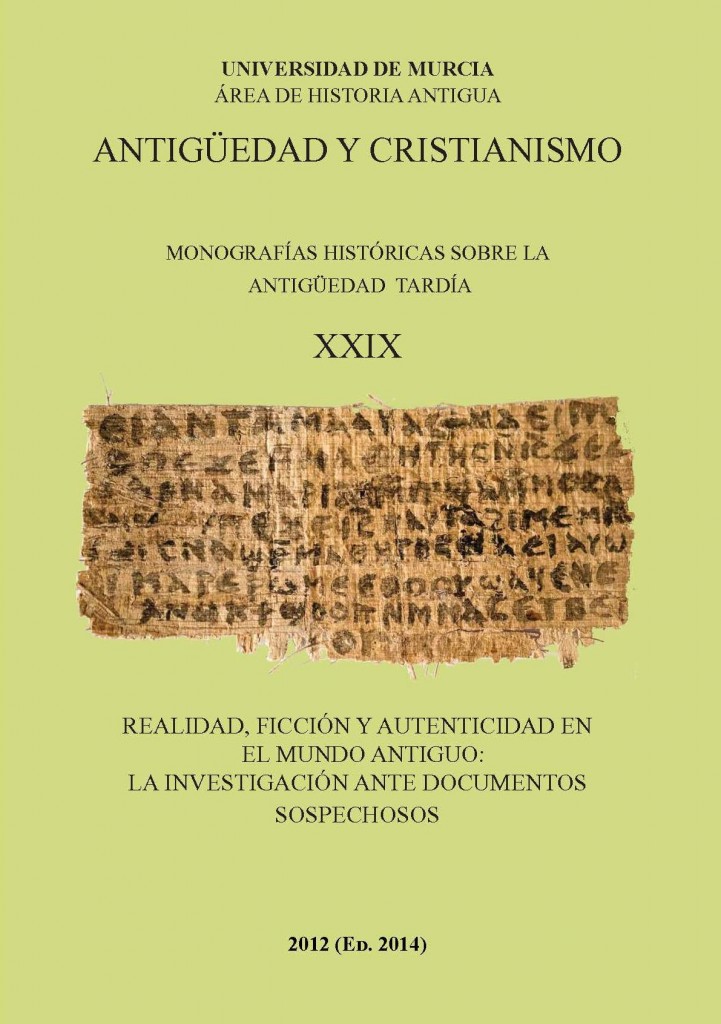El tópico del manuscrito reencontrado en la encrucijada entre tradición grecorromana y cristianismo en la Antigüedad Tardía
Resumen
El propósito de este ensayo es trazar algunas relaciones entre la tradición literaria grecolatina y la del primer cristianismo. Nos centraremos específicamente en el ámbito de la hagiografía y en las falsificaciones que en ella se dieron alrededor de los siglos cuarto y quinto.Para ello, analizaremos la utilización en ambas tradiciones de uno de los tópicos de la falsificación más utilizados a lo largo del tiempo: el del manuscrito reencontrado, o pseudo-documento, como elemento autorizador.
Descargas
-
Resumen301
-
PDF120
Citas
. BROWN, “The Rise and Function of the Holy Man in Late Antiquity”, The Journal of Roman Studies, 61, 1971, pp. 80–101
A. GRAFTON, Forgers and Critics: Creativity and Duplicity in Western Scholarships. Princeton, 1990, p. 9
A. GUDEMAN, «Literary Frauds among the Greeks», Classical Studies in Honour of Henry Drisler, Nueva York-Londres, 1894, pp. 52–74.
A. MOMIGLIANO, “Storiografi a su tradizione scritta e storiografi a su tradizione orale. Considerazioni generali sulle origini della storiografi a moderna” Atti della Accademia delle Scienze di Torino, 96 (1961–62): 186–197.
A. MOMIGLIANO, “Time in Ancient Historiography”, History and Theory, 6, 1966, 1–23. [Editado en español dentro de: La historiografía griega. Barcelona, 1984; pp. 66–93.
C. GARCÍA GUAL, “Un truco de la fi cción histórica: el manuscrito reencontrado” en AAVV, Cinco miradas sobre la novela histórica, Madrid, 2009.
C. GARCÍA GUAL, Los orígenes de la novela, Madrid, 1991, p. 303 y ss.
C. GARCÍA GUAL: Las primeras novelas. Madrid, Gredos, 2008; en especial las pp. 83–93, «La crisis del héroe».
D. HERNÁNDEZ DE LA FUENTE, Vidas de Pitágoras, Gerona, 2011; en especial p. 39 y ss.
E. CANTARELLA, Los suplicios capitales en Grecia y Roma, Madrid, 1996 (ed. original 1991), p. 69 y ss.
F. MESTRE, L’assaig a la literatura grega d’època imperial, Barcelona, 1991, pp. 241–266.
F. MESTRE: “Plutarco y la biografía en época imperial”, Estudios clásicos, 34, 2007, pp. 11–28.
F. YOUNG, “Classical genres in Christian guise; Christian genres in classical guise” en F. YOUNG, L. AYRES, A. LOUTH (eds.), The Cambridge history of early Christian literature, Cambridge, 2004, pp. 251 y ss.
G. FRAZER, El folklore en el Antiguo Testamento, Méjico, 2005 (ed. original de 1907), p. 205 y ss.
K.N. MHEALLAIGH, “Pseudo-Documentarism and the Limits of Ancient Fiction”, American Journal of Philology 129 (2008): 403–431; p. 408 y ss.
M. VAN UYTFANGHE, “L’hagiographie: un ‘genre’ chrétien ou antique tardif?”, Analecta Bollandiana, 111, 1–2, 1993, pp. 135–188
N. LORAUX, La ciudad dividida, Madrid, 2008 (ed. original de 1997), p. 137 y ss.
P. BROWN, “The Saint as Exemplar in Late Antiquity”, Representations, 2, 1983, p. 9.
P. PIOVANELLI, “La découverte miraculeuse du manuscrit caché, ou la fonction du prologie dans l’Apocalypse de Paul”, en B. ROUSSEL y J-D. DUBOIS (eds.), Entrer En Matière: Les Prologues, Paris, 1998; pp. 111–124.
S. GONZÁLEZ MARIN, Análisis de un género literario: las vidas de santos en la antigüedad tardía, Salamanca (tesis en red), 1996, p. 131 y ss.
W. HANSE, “Strategies of Authentication in Ancient Popular Literature” en S. PANAYOTAKIS, M. ZIMMERMAN Y W. KEULEN (eds.) The Ancient Novel and Beyond, Leiden, 2003,pp. 301–314
1. Los autores ceden de forma no exclusiva a la revista los derechos de explotación (reproducción, distribución, comunicación y transformación).
2. Las obras que se publican en esta revista están sujetas a la licencia Attribution-ShareAlike 4.0 International (CC By SA 4.0). Por lo que se pueden copiar, usar, difundir, transmitir y exponer públicamente, siempre que:
i) se cite la autoría y la fuente original de su publicación (revista, editorial y URL de la obra), permitiendo así su reconocimiento.
ii) se permite remezclar, transfromar o crear a partir del material mientras se mantenga la misma licencia del original.
Nota: Los artículos anteriores a 2022 muestran incorrectamente la licencia CC by SA en la página de resumen. Están bajo una licencia CC by NC ND tal y como se incluye en los pdfs de los artículos. Los artículos publicados en 2022 y después están bajo la licencia CC by SA.

3. Condiciones de auto-archivo. Se permite y se anima a los autores a difundir electrónicamente las versiones pre-print (versión antes de ser evaluada) y/o post-print (versión evaluada y aceptada para su publicación) de sus obras antes de su publicación, ya que favorece su circulación y difusión más temprana y con ello un posible aumento en su citación y alcance entre la comunidad académica. Color RoMEO: verde.
























